Discover 11 hidden attractions, cool sights, and unusual things to do in Middlesex Fells Reservation (United States). Don't miss out on these must-see attractions: Salem Street Burying Ground, Medford Pipe Bridge, and Middlesex Fells Reservation Parkways. Also, be sure to include Albree-Hall-Lawrence House in your itinerary.
Below, you can find the list of the most amazing places you should visit in Middlesex Fells Reservation (Massachusetts).
Table of Contents
Salem Street Burying Ground

Cemetery in Medford, Massachusetts. Salem Street Burying Ground is a cemetery located at the intersection of Salem Street and Riverside Avenue in Medford, Massachusetts. The Salem Street Burying Ground was used exclusively from the late 17th century to the late 19th century for the burial of the town's wealthy. The cemetery was listed on the National Register of Historic Places in 1981.
The Salem Street Burying Ground was originally the private cemetery of the Wade family. It was acquired by the town of Medford in May 1717. The earliest stone is dated 1683 and the latest 1881. Records indicate that there are six hundred people buried there, but there are only 485 markers. There are several known reasons for this discrepancy.
During the 17th century, one gravestone often marked the burial place of several members of the same family. The final resting place of no less than four members of the Wade family is marked by a single large, brown, slate block; among the largest in the burial ground. Similarly, near the Riverside Avenue entrance of the cemetery, a flagpole and granite stone marker (pictured) commemorate the graves of several unknown Revolutionary war soldiers buried there. The marker's text reads, "In Memory of New Hampshire Soldiers who Fell at Bunker Hill Buried in this Town and Interred at this Spot."
Records also indicated that there are more than fifty slaves buried in unmarked graves in the southwest corner of the cemetery.[1]
Medford Pipe Bridge
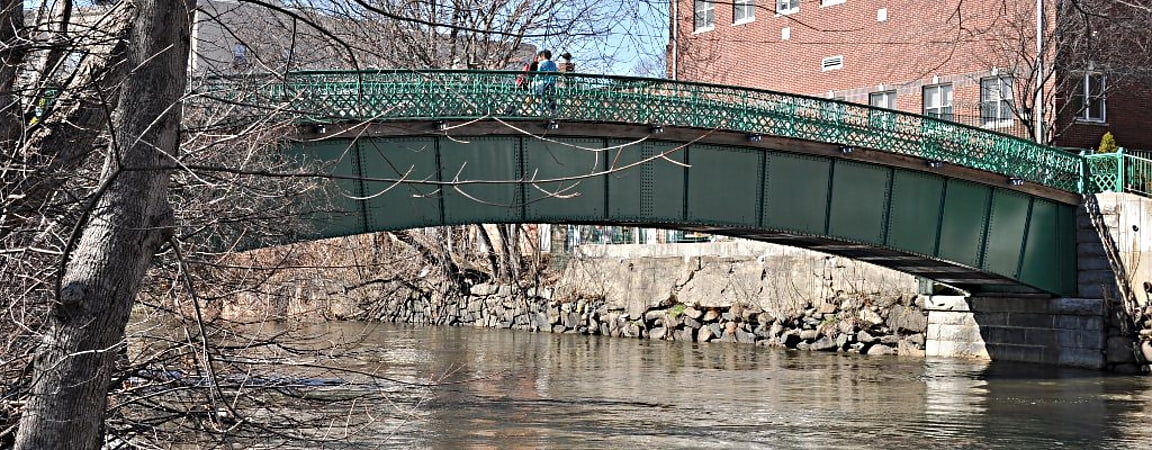
Bridge in Medford. The Medford Pipe Bridge is a historic plate girder pipeline bridge over the Mystic River, between S. Court St. and the Mystic Valley Parkway in Medford, Massachusetts. It was built in 1897 as part of the Metropolitan Water Board's northern high and low service.
The bridge carries a 20" high-service pipe and a 48" low-service pipe between the Chestnut Hill Reservoir and Spot Pond that are cross connected with the Mystic Water Works pumping station in Somerville. The bridge was built by the New Jersey Steel & Iron Company in Trenton, New Jersey, and placed on abutments designed by Cheney & Trumbull. It also carries foot traffic.
The bridge was listed on the National Register of Historic Places in 1990. A postcard ca. 1938 calls it the "Foot Bridge over Mystic River", Medford, Mass.[2]
Middlesex Fells Reservation Parkways
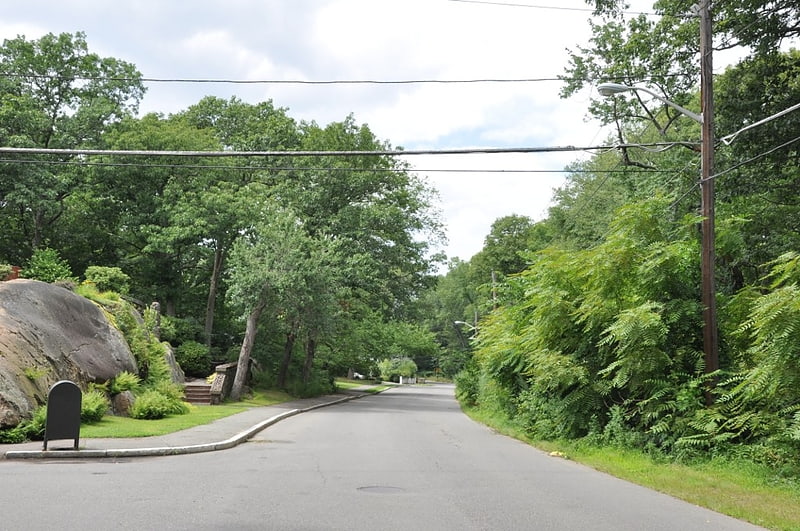
The Middlesex Fells Reservation Parkways are the roadways within and bordering on the Middlesex Fells Reservation, a state park in the northern suburbs of Boston, Massachusetts. The park includes portions of the towns of Malden, Medford, Melrose, Stoneham, and Winchester. The roads inside the park and around its perimeter have been listed on the National Register of Historic Places. Other portions of some of the roads are covered by more than one listing in the national register; see Fellsway Connector Parkways and Middlesex Fells Reservoirs Historic District.
The Middlesex Fells Reservation is one of the oldest and largest of the parks in the Metropolitan Park System of Greater Boston. The reservation was created in 1894 with a gift of 450 hectares (1,100 acres) of land from The Trustees of Reservations to the Metropolitan Parks Commission, predecessor organization to the Metropolitan District Commission and today's Massachusetts Department of Conservation and Recreation (DCR). By 1897 the park had been expanded to some 3,000 acres (1,200 ha). This area included some existing roadways, which became internal roadways of the park. The border roads that surround the park followed a principle articulated by landscape designer Charles Eliot, who was instrumental in the preservation of the Fells, that such roads clearly delineated the bounds of the park, and provided its neighbors with pleasing views.[3]
Albree-Hall-Lawrence House
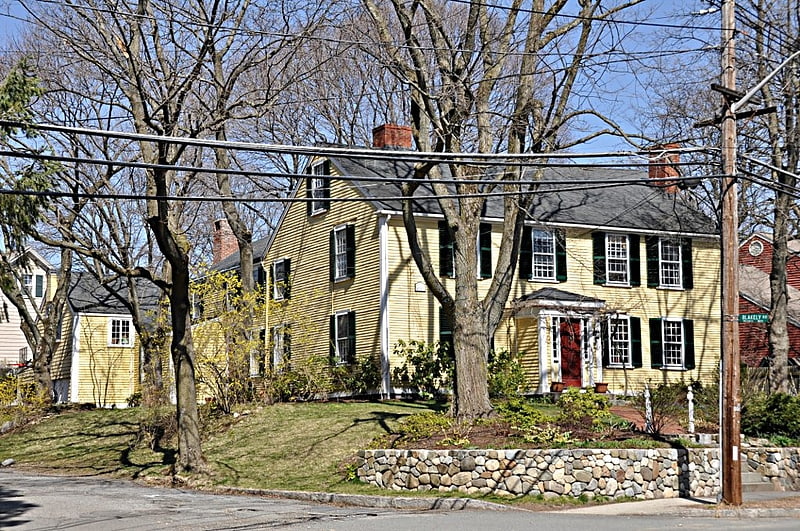
Historical landmark in Medford, Massachusetts. The Albree-Hall-Lawrence House is a historic house located at 353 Lawrence Road in Medford, Massachusetts.[4]
Address: 353 Lawrence Road, Middlesex Fells Reservation (Medford)
Henry Bradlee Jr. House
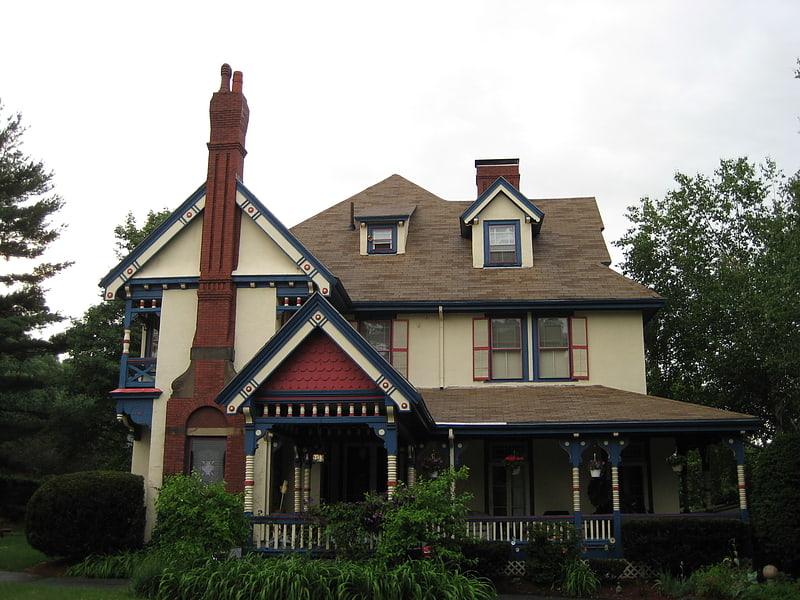
The Henry Bradlee Junior House is located in Medford, Massachusetts. It was designed in the Queen Anne style by Peabody & Stearns circa 1881–1882. This was one of three houses built by the Halls and the Bradlees on their estate.
This home was built for Henry Bradlee Junior, his wife Maude (Abbot) Bradlee and their son, Edward who was born in Boston in 1880. Henry and Maude were married on January 21, 1879 and this house was in part a wedding gift to them. They were married by Rev Leighton Parks in Boston, Massachusetts.
The other two houses were built in the mid to late 1850s for Dudley C. Hall and for Henry Bradlee Sr. and his wife Hepsa Hall Bradlee. Of those homes, according to a survey by the Massachusetts Historical Commission, the Henry Bradlee Junior House is the best preserved.
The MHC report states in part:
Its many porches, turned posts, balconies, porte-cochere and chimney with divided flues (to allow space for a window to be placed in the center of its base) are the best details of their type in Medford. Mentioned in a deed of 1882, the house was probably constructed between March 1881 when the one and three-quarter acre parcel on which it stood was first surveyed, and April 1882, when Dudley Bradlee granted a mortgage on the property to Henry Bradlee and his wife, Maude.
The only major alteration to the house has been the replacement of its original decorative shingle work with stucco. This change was probably made around 1910 when the area was being built up with fashionable Stucco Style houses.
Henry Bradlee Junior came from an upper-class family from the Medford and Boston area. He was born January 30, 1851, and died April 13, 1894. His grandfather, Josiah Bradlee of Boston is known to have participated in the event known as the Boston Tea Party in 1773. He was a descendant of Governor Simon Bradstreet of the Massachusetts Bay Colony, as well as of Charles Tufts. Henry Bradlee Jr. had two siblings, Ellen Marion Bradlee and Dudley Hall Bradlee.[5]
United States Post Office–Medford Main
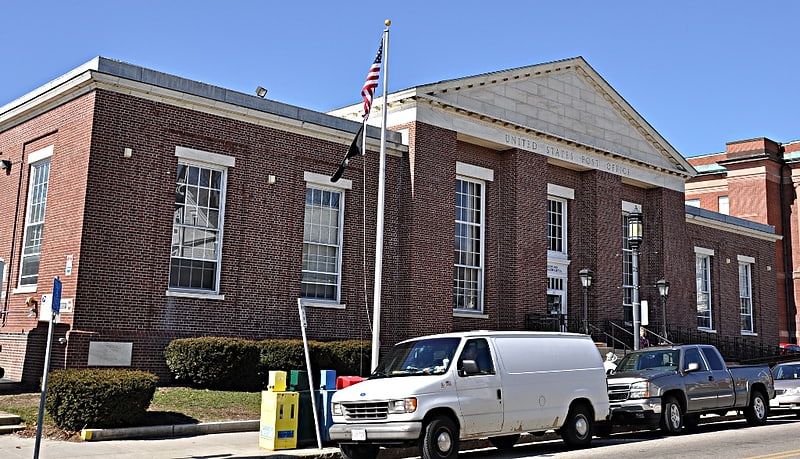
The US Post Office–Medford Main is a historic post office at 20 Forest Street in Medford, Massachusetts. Built in 1937, it is a fine example of construction work funded by the Public Works Administration, a jobs program of the 1930s. It was listed on the National Register of Historic Places in 1986.[6]
John B. Angier House
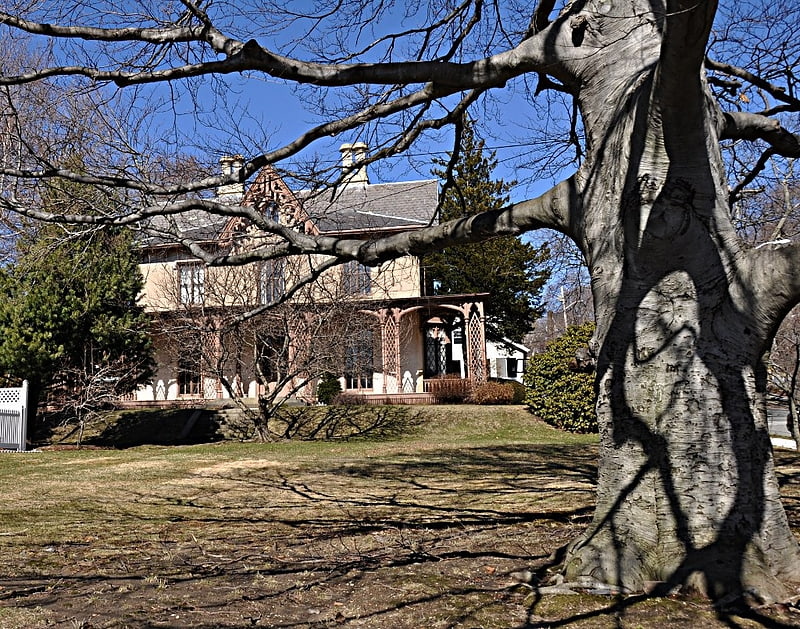
Historical landmark in Medford, Massachusetts. The John B. Angier House is a historic house located at 129 High Street in Medford, Massachusetts.[7]
Lawrence Light Guard Armory
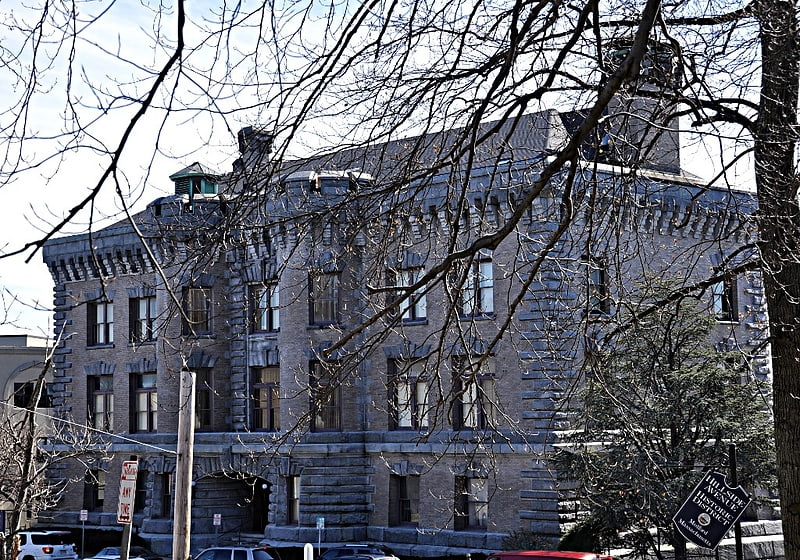
Building in Medford, Massachusetts. The Lawrence Light Guard Armory is a historic armory building at 92 High Street in Medford, Massachusetts. The three-story granite and brick building was built in 1891 to a design by Shepley, Rutan and Coolidge. The Romanesque Revival building has massive granite quoins on the corners, a granite course between the first and second floors, and granite lintel sections above its windows. The entrance, centered on the north facade, is flanked by round turrets with crenellated tops.
The building was listed on the National Register of Historic Places in 1975.[8]
Bigelow Block

Building in Medford, Massachusetts. The Bigelow Block is a historic commercial and residential building at the corner of Forest and Salem Streets in Medford, Massachusetts. The Victorian block was built in 1886 for the locally prominent Bigelow family; it is a four-story brick building with sandstone trim, terra cotta plaques, and copper-clad turret at the corner. It occupies a prominent position in the center of Medford, and is one of few surviving 19th century commercial buildings in the city.
The building was listed on the National Register of Historic Places in 1975.[9]
Peter Tufts House

Historical landmark in Medford, Massachusetts. The Peter Tufts House is a Colonial American house located in Medford, Massachusetts. It is thought to have been built between 1677 and 1678. Past historians considered it to be the oldest brick house in the United States, although that distinction belongs to Bacon's Castle, the 1665 plantation home of Virginian Arthur Allen. It is also believed to be, possibly, the oldest surviving house in the U.S. with a gambrel roof.
Its brick walls are 18 inches (0.46 m) thick. Its end chimneys were incorporated into the walls, which is unusual for the time and area of its construction, and its "separate flues are brought together in the gables. The steep main roof slope (51°) is truncated at the top to form one of the earliest-known gambrel roofs."[10]
Joseph K. Manning House
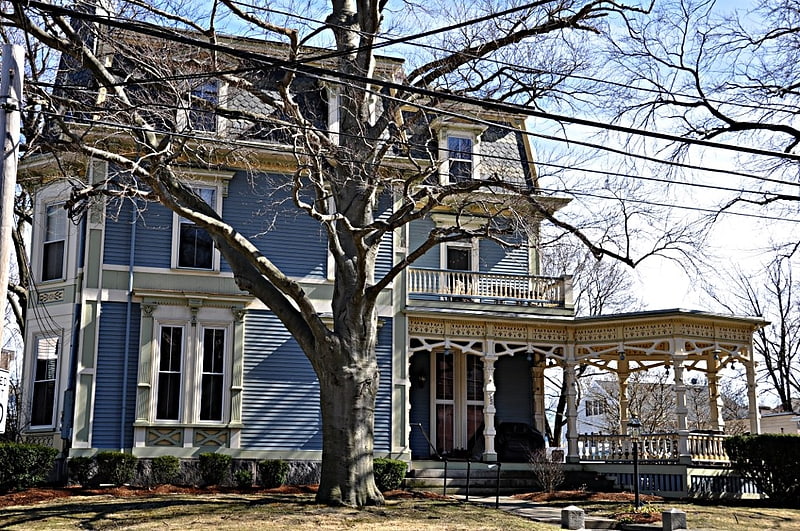
Building in Medford, Massachusetts. The Joseph K. Manning House is a historic house in Medford, Massachusetts. Built in 1875, this three story wood-frame house is the most elaborate Second Empire house in the city. The most prominent feature of this architecturally complex building is a hexagonal pavilion attached to its porch at the western corner. It has an elaborate jigsaw-cut frieze and Stick style decorative woodwork, with a balustrade with heavy turned balusters. The house's mansard roof is shingled in multiple bands of colored slate, and pierced by pedimented dormers. At the upper roof line there is iron cresting. The house was built for Joseph King Manning, the son of a wealthy lumber dealer.
The house was listed on the National Register of Historic Places in 1989.[11]